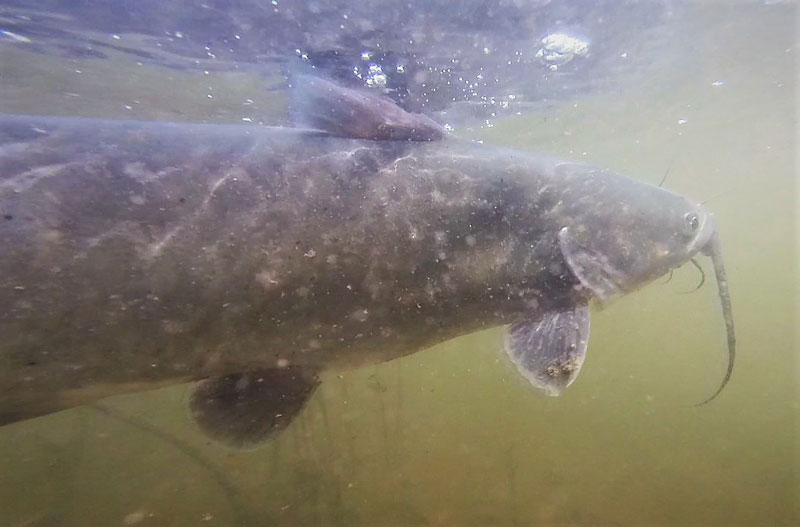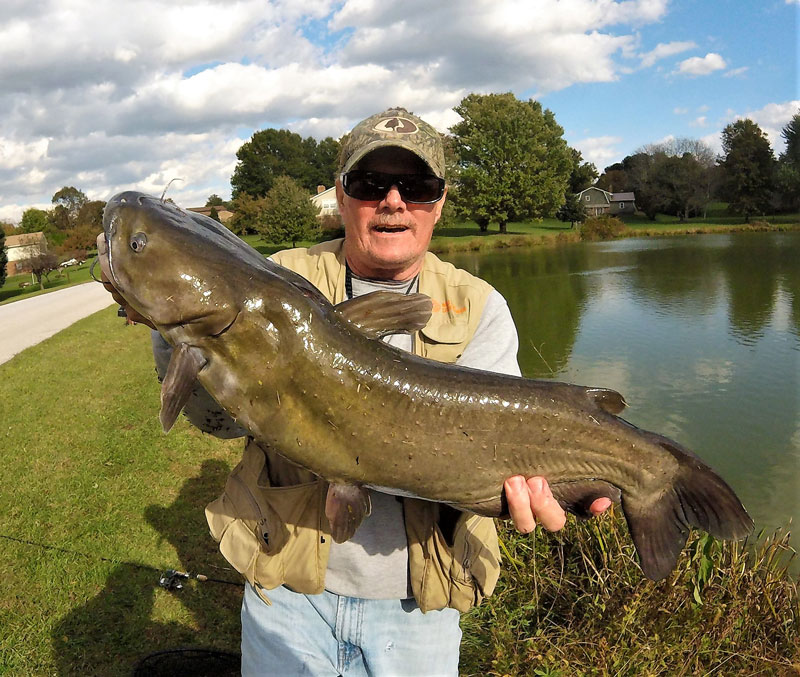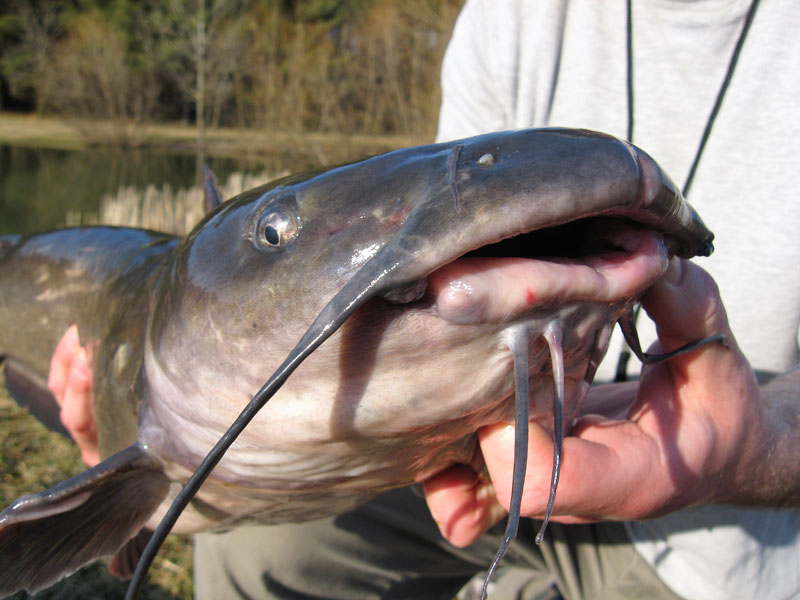Monster catfish are known to swim in the Chesapeake and its tributaries, but what about freshwater lakes, rivers, and ponds? They are out there – big, barrel-chested fish that are ready to fight. They are cruising the shallows in the early morning and lurking in the darkest depths during the heat of the day. They are at home in small community lakes and ponds, small streams and river systems, and practically anywhere you might catch bass, trout, panfish or other headliners. Often they are forgotten, having been stocked years ago to perhaps fuel a children’s fishing event. Over time, some of them got big, real big. Thirty-inchers aren’t all that rare, and we hear stories of busted tackle that was just too light. The truth is out there, swimming around in waters you probably already fish.

Throughout my lifetime of angling I have had many opportunities to hook and sometimes land marauding, overgrown channel catfish from a variety of waters – most of which were overlooked and passed over by the masses. Cats are very popular as a sport and food fish and often are the fodder for a fish fry. In the Chesapeake Bay region, the Upper Bay rivers and tributaries hold a good population of cats that have made their way out into the Bay due to the tremendous influence of runoff over the past two years, thanks to the record-breaking rainfall amounts. This has added a new dimension to Bay fishing in the region. However, it is those smaller park lakes, farm ponds, and small tributaries that hold some of the biggest and best surprises.
Traditionally, channel cat anglers target their fish in larger river systems with fresh cut baits. Many pursue them at night or during overcast, low-light conditions. Appropriate gear can be beefy to accommodate current, tides, and the possibility of large fish (including blue catfish, in many cases). However, the element of surprise is ever present when fishing for other species such as bass or panfish. Ten to 15 pound and larger channel cats just seem to show up when least expected. Usually, I find myself way under-gunned for big fish on four-pound test lines. But with patience and a little luck, those brawny cats can be conquered on lighter, even diminutive gear.
Lures that Work for Catfish
I’m sure that many anglers can recall an instance where a big cat crushed a lure and gave them the thrill of the season… until they saw that the fish was indeed a channel catfish. But I find this to be an attribute of a great gamefish that’s willing to strike lures with regularity and provide powerful fights that can challenge an anglers fish-playing skills. I once caught a 31-inch channel that smashed a number-five Mepps spinner in a small park lake in the middle of July, during the heat of a 95-degree day. The water had been muddied from recent thunderstorms and I was hoping to catch a few largemouths. Didn’t happen, and I knew right away that the thunderous strike was no bass. The big kitty had completely engulfed the lure and bent the spinner shaft into a 45-degree angle. After struggling to take a few selfies of the fish, I watched her head back to the murky depths. In no way was I disappointed, nor discouraged, because of the species.

We’ve encountered many other high-end channel cats on lures over the years as accidental catches. Other lures that have attracted them are spinnerbaits, shad darts, micro-sized panfish jigs, plastic worms, Rapala and Matzuo crankbaits, hair jigs, tubes, and even a variety of surface lures including the classic Arbogast Jitterbug and the River2Sea Whopper Plopper. Most of the time, I seem to hook big channel cats on panfish jigs and light lines. The largest I’ve caught to date in this sort of encounter is a 33-inch fish that took a 1/64th ounce hair jig while I was trout fishing with a float-and-fly setup. That fish nearly spooled me twice before I was able to get a net under it. Bait-tipping on small jigs, a standard to attract various panfish species, can be a catfish attraction as well. But often, hungry channel cats need only be at the right-place, right-time situation for a memorable, light-tackle bout.
Where and When to Target Catfish
Cooperative cats have likely been stocked in a number of small, public venues near you. Park and community lakes, along with private ponds and numerous spillways and millponds, see occasional implants and runs of them as they are easy to raise and provide good angling opportunities for children’s fishing events. They have high survivability and holdover well, often attaining great size. The largest I have seen locally went just over 22-pounds and came from a small park pond that is passed by thousands of motorists every day. At another facility I once watched an angler skillfully play a huge, rotund channel that was well over 30-inches. He had hooked the fish on a crankbait while bass fishing and just took his time with the behemoth, until it finally tired out. Calmly and swiftly, he unhooked the cat and set her free as a small crowd had gathered to witness the event. Cool!
Despite their relatively small size, tributary creeks to the Potomac, Monocacy and Susquehanna systems can and do also hold bulky cats that few anglers are aware of. Last August, I hooked and landed a fat and crazy cat in a tiny stream near the Mason Dixon Line. The fish clubbed my Matzuo Nano Crank minnow and it was a crazy, hectic, toe-to-toe battle for several minutes until I finally ushered the creek-monster into the shallows. I could not believe that the little pocket I had just cast in could possibly yield a fish near 30-inches, but it did! Later in the summer, I cautiously waded a stretch of stream and viewed a pack of five- to seven-pound channels that were corralling crayfish and minnows in another Potomac tributary. With snags and overhangs, I decided not to press my luck with my ultralight spinning gear.

Summertime storms and rain can trigger channel cat activity in not only smaller creeks, but in flatwater environments as well. Much as we’ve seen in the Bay this year, it’s like they just come out of the woodwork and there they are. At the opposite end of the extreme, during the low-water periods of late summer creek cats will hole up in the deepest possible pockets and pools, especially if there’s fallen wood or incoming riffles that can oxygenate the water. And if nighttime angling is an option at your favorite catfish hole then it may be time for some static bait options with chicken livers, cut bait, or flavored hot dog chunks on 2/0 circle hooks set on the bottom. So experiment this summer in of those overlooked and untapped options, and you’ll likely encounter some barrel-chested summertime channel catfish.
-By Jim Gronaw